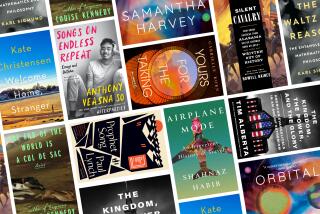Let go, yet hold on
- Share via
The New Yorker magazine has announced that its complete 80-year archive will soon be available on eight computer discs. Some people found this development interesting. But to many, many, many others -- and you know who you are, hoarders of America -- the idea of being able to own eight DVDs containing every page of the 4,109 issues of the weekly magazine published between February 1925 and February 2005 was life-changing. Here, from the wise and benevolent goddess of technology, was a solution to an all too common stuff-management problem.
*
The New Yorker’s news was so liberating. No more piles to hide atop the washing machine before guests arrive. Now the stack in the downstairs coat closet can go, along with the basket-full of issues in my bathroom, and the tower occupying the southwest corner of my home office. The New Yorker plans to issue annual updates to the disc collection, and surely other magazines will follow suit, once they realize selling their archives represents both a source of revenue and a public service.
Imagine all the country’s registered pack rats heaving their collections of New Yorkers and National Geographics into the ocean. You can see the horizon tilt, can’t you?
The set of discs will take up less space than a few copies of the magazine. Even better, they’ll be searchable. Only a die-hard Luddite could deny that popping a DVD into the computer and searching for an author, artist, title or subject using key words is preferable to communing in the garage with Charlotte, the spider, hunting through clutter when a sudden urge to read Dr. Jerome Groopman’s May 1998 examination of the hepatitis C epidemic strikes.
Before the digital age, various coping strategies were employed by those of us not readily disposed to dispose of anything but furry food and a first husband’s college sweatshirt. For magazines that, once in the house, tend to take root, there’s the throw-the-darn-things-out-at-the-end-of-the-month-read-or-not tack. And the save-only-issues-with-Post-Its-marking-articles-to-be-read plan. Let’s not forget the cancel-the-subscription method, which, while Draconian, does solve the problem.
Why keep old magazines at all? The optimist in me anticipates a better future, a day when I’ll have the time to complete every periodical before its pages yellow. (It would be unkind for anyone to point out that it’s my inner obsessive who feels that reading everything but Golf Digest, Foreign Affairs and Truck’N Trailer Magazine is a necessity.)
Beneath optimism and compulsion, there’s fear. Fear that the day might come when some tidbit of wisdom hidden between soft covers will be needed. Or fear of boredom. What if the Big One hits, and electricity isn’t restored for weeks and batteries can’t be had? Well, even if I’ve finished every book in the house, I’ll be assured of something to read. And plenty of droll cartoons to chuckle at. Given a disaster scenario, more practical folk would likely be concerned with obtaining, preserving and preparing food. We all have our priorities.
Even when most determined to deaccession, I am not capable of just tossing winter 1994 through summer 1996. I must admit that there are always some stories that don’t attract my interest. But after a New Yorker has sat around a few years, its maturity becomes self-justifying. There must have been some reason I’d hung on to it.
So the elimination process begins with scanning the tables of contents. I’m as brutal as possible, but inevitably, I’ll clip a few articles to read later. Once begun, the act of cleansing is so satisfying that I am gripped by an urge to complete the task, and I read the clipped pieces promptly and throw them away. Really.
We in the news biz live with the knowledge that today’s newsprint will be tomorrow’s fish wrapping. Yet much of the gossip and information in the New Yorker seems richer when aged. Reading analyses of events and culture that were once timely, now outdated, moves them from the category of news into history.
A recent purge yielded several treasures, such as an essay about Lady Diana written by British journalist and novelist Allison Pearson before the princess’ 1997 death. Pearson’s insights, free of “don’t speak ill of the dead” propriety, were fascinating. “Adaptation” opened in theaters in 2002. After seeing the movie, some of us could enjoy its source material, “The Orchid Thief” by Susan Orlean, originally published in the New Yorker in 1998, because that issue was still around, uh, somewhere.
Now that the chore of sooner or later having to sift through my personal New Yorker stash has been eliminated, other projects can move up the list in my obsessive-compulsive’s notebook. Before you know it, I’ll have alphabetized my spices. Color graded my sock drawer. Best of all, I can let go of my hoarder’s guilt, because the New Yorker’s digitized archive not only satisfies a collectors’ needs, it justifies our actions. The magazine is issuing 200,000 copies of the disc set in a first printing, priced at $100 each. Obviously, I’m not the only one crazy enough to think that saving all that printed matter is a good idea.
Avins can be reached at [email protected].
More to Read
Sign up for our Book Club newsletter
Get the latest news, events and more from the Los Angeles Times Book Club, and help us get L.A. reading and talking.
You may occasionally receive promotional content from the Los Angeles Times.






